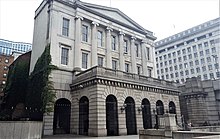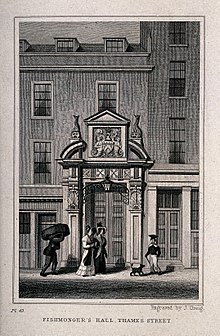
Fishmongers' Hall (sometimes shortened in common parlance to Fish Hall) is a Grade II* listed building adjacent to London Bridge. It is the headquarters of the Worshipful Company of Fishmongers, one of the 111 livery companies of the City of London. The Hall is situated in Bridge ward.
The buildings


The first recorded Fishmongers' Hall was built in 1310. A new hall, on the present site, was bequeathed to the Company in 1434. Together with 43 other livery halls, it was destroyed in the Great Fire of London in 1666 and a replacement hall designed by the architect Edward Jerman opened in 1671. This hall by Jerman was demolished to facilitate the construction of the new London Bridge in 1827. The Fishmongers' fourth hall was designed by Henry Roberts (although his assistant, later the celebrated Sir Gilbert Scott, made the drawings) and built by William Cubitt & Company, opening in 1834. After severe bomb damage during the Blitz, Fishmongers' Hall was restored by Austen Hall (of Whinney, Son & Austen Hall) and reopened in 1951.
The contents
The collection in Fishmongers' Hall includes:
- the 1955 portrait of Queen Elizabeth II by Pietro Annigoni
- a collection of 17th- and 18th-century silver
- an embroidered 15th-century funeral pall
- two portraits by George Romney
- river scenes painted by Samuel Scott
The hall also holds a dagger that at one time was popularly believed to have been used by Lord Mayor Walworth to kill Wat Tyler in 1381, and was said to have been given to the City armoury by the king. However, there was no foundation to this legend, as the weapon was in the armoury long beforehand where it was used to represent the sword of St Paul.
2019 stabbing
Main article: 2019 London Bridge stabbingOn 29 November 2019, Usman Khan, a prisoner attending a Cambridge University conference on prisoner rehabilitation at the hall, wearing what turned out to be a fake suicide vest, threatened to blow up the hall. He subsequently stabbed a number of people in the hall, and two of them – Jack Merritt, a 25-year-old Cambridge University employee, and Saskia Jones, a 23-year-old volunteer – died of their injuries. Khan was wrestled to the ground on the bridge by members of the public, before being shot dead by armed policemen; a Polish man used a pole as a weapon to fight off the attacker, while another man used a narwhal tusk which he had taken from the wall inside Fishmongers' Hall.
References
- Historic England. "Fishmongers' Hall (1359203)". National Heritage List for England. Retrieved 17 June 2015.
- "William Cubitt & Co". Scottish Architects. Retrieved 4 June 2012.
- "Worshipful Company of Fishmongers". London Metropolitan Archives. Retrieved 10 May 2021.
- "News Release: Annigoni's great 1950s painting of the Queen goes on show for the first time in 26 years in Diamond Jubilee Exhibition". National Portrait Gallery. Retrieved 12 June 2012.
- ^ "Visit to Fishmongers' Hall". The Chelsea Society. 23 November 2013. Retrieved 17 May 2024.
- John Timbs (1855). Curiosities of London: Exhibiting the Most Rare and Remarkable Objects of Interest in the Metropolis. David Bogue, 86 Fleet Street. p. 350.
- Charles Knight, ed. (1843). London. Vol. IV. p. 197.
- Brown, David; et al. (30 November 2019). "The Terrorist Wearing a Tag". The Times.
- "London Bridge attack victim named". 30 November 2019. Retrieved 1 December 2019.
- "Second London Bridge victim named as Saskia Jones". 1 December 2019. Retrieved 1 December 2019.
- (4 December 2019). London Bridge: Usman Khan completed untested rehabilitation scheme. BBC News Online.
External links
51°30′34″N 0°05′16″W / 51.50939°N 0.08764°W / 51.50939; -0.08764
Categories: